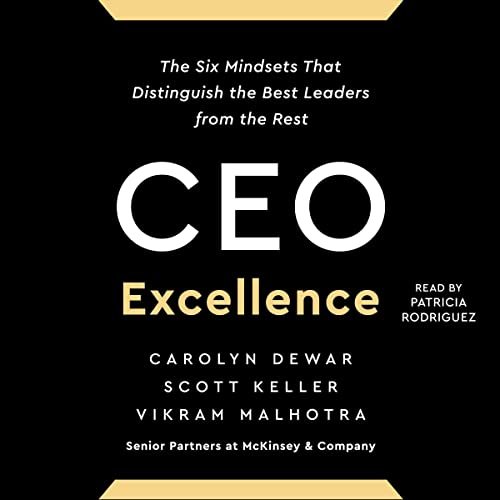CEO Excellence: The Six Mindsets That Distinguish the Best Leaders from the Rest
It's no secret that CEOs are the most visible and powerful figures in any organization. They take on a tremendous responsibility to deliver shareholder value and often command the highest wages.
But while they may carry the weight of a company's success on their shoulders, research shows that nearly 30% of Fortune 500 CEOs last fewer than three years, and two out of five CEOs fail within the first 18 months.
This begs the question: What mindsets distinguish the most successful CEOs from their peers?
To answer this, Dewar, Keller, and Malhotra of McKinsey & Co. sought to understand the mindsets of 67 of the top CEOs from a pool of 2,400 companies for their book titled CEO Excellence: The Six Mindsets That Distinguish the Best Leaders from the Rest.
In this blog post, I'll provide a review of the book and discuss how CEOs can apply the six mindsets to their own leadership approach.
So, whether you're an aspiring CEO or a corporate executive looking to maximize your impact, this review will give you a great starting point on the path toward success. Let's get started!
The Six Mindsets:
The first mindset is "setting the direction" for the company. This involves articulating a clear vision and roadmap for the future, which includes growth areas, diversification, or acquisition. A CEO must also develop a clear strategy and break long-term goals into short-term plans. This mindset enables the allocation of limited resources and prepares for future uncertainties.
The second mindset is "aligning the organization to these objectives and strategies." This can be challenging, especially for older companies with entrenched mindsets and structures. CEOs must change the culture of the organization to align with the new direction, and this often involves the organizational design, including the creation of new positions and reskilling of staff. Successful CEOs must also balance the cost of bringing in new talent with retaining current staff.
The third mindset is "identifying leaders" who can execute the plans. CEOs may have biases in hiring, but it is crucial to get the mix right to ensure that plans are executed effectively. Leaders within the organization must form their teams and choose to hire internally or externally. CEOs must consider tenures and experience to avoid dissatisfaction within the organization.
The fourth mindset is a "different kind of challenge" that involves engaging with the board. Managing the board is the most significant task for a CEO, and it can be challenging due to different commitments and backgrounds. CEOs must handle questions and conflicts with maturity, as board meetings are where all strategies get approved.
The fifth mindset is "connecting with stakeholders," including shareholders, clients/customers, employees, government officials, regulators, and investors. CEOs must engage with all stakeholders to ensure the company is on the right track, especially with an increasing focus on ESG. CEOs must regularly communicate progress and engage with investors to stay connected to the market.
The final mindset is "managing personal effectiveness," which involves delegating tasks and focusing on what matters at the CEO level. CEOs must become company ambassadors and behave like one. Insecurity can be a hurdle to delegation, but it is essential to manage personal effectiveness effectively.
What I Really Appreciate about the Book:
The best part about this book is that several exercises and real-life examples accompany each mindset to help readers understand how they can put these principles into practice. The author, Wilson, provides a clear roadmap for developing each of the six mindsets required to become a successful leader.
What sets this book apart from others is the actionable advice that is presented in a way that is easy to understand and apply. Instead of just describing the mindset needed for success, the book provides concrete examples and exercises that help the reader to develop and apply these concepts to their own life and work.
This approach ensures that the book is not just informative but genuinely useful for anyone who wants to improve their leadership skills. The exercises and examples provided allow the reader to test their own assumptions and reflect on their leadership style, encouraging them to take action and make changes where necessary.
The result is a book that is both practical and inspiring, providing readers with the tools they need to become effective leaders in their own right. Whether you are an aspiring leader or an experienced CEO, this book will help you develop the mindset required for success in today's fast-paced and ever-changing business world.
Final Thoughts:
All in all, I found "CEO Excellence: The Six Mindsets That Distinguish the Best Leaders from the Rest" to be an incredibly useful and informative book. It provides a comprehensive roadmap for developing the right mindset to become successful in today's business world.
It is packed with actionable advice and real-life examples that make it easy to understand and apply the principles discussed. Whether you are an experienced CEO or an aspiring leader, this book will help you develop the skills required to excel in your field.
I Highly recommend this book to anyone who is looking to improve their leadership skills. It will help you develop the mindsets needed to become an effective leader and provide you with the tools to succeed in your chosen field.
Want to take it a step further and discover a great insight into what it takes to manage a non-profit organization? Hour by hour to practical tips. Check out the Day in the Life of a Nonprofit Executive below.

